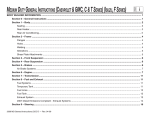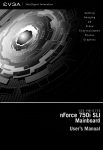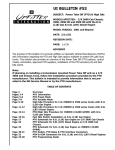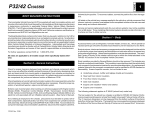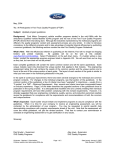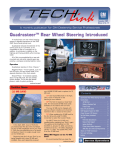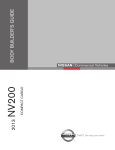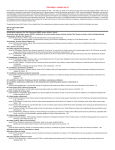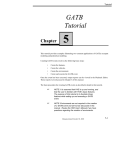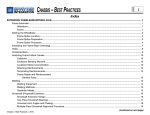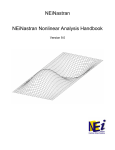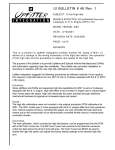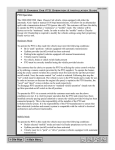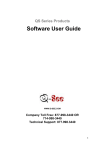Download C/K TRUCK (NEW)
Transcript
PAGE C/K TRUCK (NEW) BODY BUILDERS INSTRUCTIONS The Incomplete Vehicle Document (IVD) is supplied with each incomplete vehicle, and provides information that should be used by intermediate and final stage manufacturers in determining conformity to applicable Federal Motor Vehicle Safety Standards (FMVSS). The IVD also includes information which must be followed in order to ensure that Environmental Protection Agency (EPA) and California emissions certification requirements and NHTSA Fuel Regulations are met. This Body Builders Book contains information that may be used in addition to the IVD for any manufacturer making alterations to a complete/incomplete vehicle. No alteration should be made to the incomplete vehicle which either directly or indirectly results in any component, assembly or system being in nonconformance with any applicable Federal Motor Vehicle Safety Standard or Emission Regulation. Intermediate and final stage manufacturers should be familiar with all Federal Motor Vehicle Safety Standards and Emission Regulations and aware of their specific responsibilities as manufacturers. For further assistance contact Upfitter Integration at: 1 (800) 875-4742 1 When welding components to the frame assembly, remove the wax coating in the area of the weld in order to obtain secure welds. After completion of the weld, a compatible corrosion protection should be applied to the affected weld areas. All labels on the vehicle (any message applied to the vehicle or vehicle component that informs, instructs, or warns) must appear on the completed vehicle so the user can read them easily and without obstruction. Those installing aftermarket systems should provide information as to where and how to obtain service and replacement parts. When installing a Power Take-Off (PTO) with hydraulic lines, the following care should be exercised: Route and secure all hydraulic lines so that they are not in close proximity to any parts of the exhaust system. Keep all fittings and connections away from the exhaust system. Make sure connections and fittings cannot leak on the exhaust system. Exhaust system heat can damage and degrade hydraulic lines and components. Oils and hydraulic fluid coming in contact with a hot exhaust system could result in a fire. Section 0 – General Instructions Section 1 – Body Check for proper clearance between body members and chassis components which may in any way affect the reliability and performance of the vehicle by developing abrasion and wear points from moving parts or degradation from extreme environment or thermal exposure or may increase interior noise. Accessory items such as refrigerator, hot water heater, furnace, etc., which operate on liquid propane gas should be located and protected to prevent exposure to any flame. Check headlamp aim and all vehicle illumination systems for proper operation when the vehicle has been completed. Re-aim headlamps when necessary. Check for proper operation of windshield washer, wipers and defroster system. GM has established automotive refinishing standards for itsef as well as its aftermarket retailers. Each division require the dealer or retailer to use only materials and methods that meet GM standard GM 4901M when repairing, replacing or refinishing vehicles Extreme care must be taken when working on vehicles equipped with Engine Control Module (ECM), Powertrain Control Module (PCM), Transmission Control Module (TCM), Vehicle Control Module (VCM) or any electronic unit associated with an inflatable restraint system. (See Owner’s Manual). Each year, all new paint systems will be tested and evaluated. New or improved products will also be tested. The paint systems that pas this annual testing process will be published in this booklet, updated annually If arc-welding is employed on the chassis, precautions must be taken to protect all vehicle components, especially brake and fuel lines, fuel tank assembly, electrical wiring and ECM/PCM/TCM or VCM. To avoid electronic component damage, disconnect battery (batteries); disconnect the negative cable first, followed by the positive. To reconnect cables; connect the positive first, then the negative. CK New Rev. 12/98 Rev. 11/99 If GM 4901M booklets are needed, call 1–800–269–5100 Body structures, interior and accessory arrangements must be designed into the vehicle to provide for proper load distribution on both axles and not to exceed any gross axle weight ratings. Lateral load equalization must also be maintained. The resultant Center of Gravity of the unladen vehicle must be within the limits tabulated in the FMVSS 105 section of the Incomplete Vehicle Document. PAGE 2 Body insulation provided by General Motors should not be removed. This includes any thermal or underbody heat shields. This insulation is provided to protect the vehicle body and occupants from excessive heat and/or provide noise attenuation. Any replacement material internal to the occupant compartment must be certified for FMVSS 302 Flammability of Interior Materials. Areas of specific concern, but not limited to are: D Underbody exhaust, muffler and tailpipe shields and insulators. D Rear load floor interior insulation. D Front floor interior insulation. D Dash mat insulation. D Engine cowl insulation - interior and exterior. D Engine cover insulation. D Hood Insulation C/K TRUCK (NEW) lines. This allows a one time only connection to the O.E.M. charged A/C system without having to discharge, evacuate and recharge for the connection of a rear A/C system. A modification to the A/C system which causes the A/C plumbing lines to increase in length (such as the addition of a rear after-market evaporator and blower assembly) will necessitate the following changes: D Lubrication – PAG refrigerant oil must be added to rear system to provide lubrication for compressor. Refer to Service Manual for specifications. D Refrigerant – Add R-134A refrigerant to system based on sizing of new tubes, hoses and evaporator. Contact your A/C supplier for recommended charge.Label – Revise/modify GM charge label (located on top of front evaporator or A/C bottle) from factory recommended charge for a front system only to body builder’s new recommended dual system per SAE J639. This is important for servicing the A/C system so that the technician knows the correct amount to add to the modified system. Conversions A minimum of 10_ departure angle should be maintained if frame and/or body is extended. Selected trim components above the belt line have energy absorbing foam added behind the trim (headliners, A, B & C garnish moldings). To comply with MVSS 201 any modification could affect compliance. If body builder installs seating other than that supplied with vehicle, it is the body builder’s responsibility to ensure that the seating and restraint systems comply with FMVSS requirements. The restraint systems supplied with the vehicle were designed to accommodate the seating reference points and seat travel of the original equipment seats only. Air Conditioning Section 2 – Frame Hole drilling, welding, modifications, or alterations to the frame assembly are the responsibility of persons performing these operations. These same individuals assume complete responsibility for frame assembly reliability, performance after alterations and compliance to applicable FMVSS requirements. The following procedures and specific precautionary instructions are recommended for proper installation of special bodies and/or equipment on GM frames. Failure to follow these recommendations could result in serious damage to the basic vehicle. Flanges Do not drill holes in frame flanges. For additional information refer to Engine - Section 6. Holes NOTE: Air conditioning systems using R-134A refrigerant are equipped with metric fittings to prevent interchange with R-12 refrigerant components. Do not interchange R-134A components, refrigerant oil or service equipment with R-12 components, refrigerant oil or service equipment. Holes to mount brackets, supports, and out-riggers must be drilled in the vertical side rail web with the following restrictions: Rear Air Conditioning This unit may be equipped with A/C quick-connect fittings (Option YF7) on the liquid tube (high pressure) and the suction (low pressure) return tube. These fittings are designed to accept matching Aeroquip connecting fittings attached to pre-charged D Material between edge of hole and inside of upper or lower flange must not be less than 37 mm (1.50 in.) for HSLA (40,000 PSI yield). D The minimum edge distance between any two (2) holes must be larger than twice the diameter of the larger hole. D No holes should exceed 20 mm (0.75 in.) in diameter. CK New Rev. 12/98 Rev. 11/99 PAGE C/K TRUCK (NEW) D All holes should be drilled in the frame using appropriate drilling practice and safety precautions. No additional holes or notching of either top or bottom frame flanges is allowed. Section 3 – Front Suspension Welding CAUTION: 3 Fuel tank and fuel lines must be drained and all vapors purged to ensure non-combustible mixture before any welding, brazing or soldering. When welding high strength low allow (HSLA 40,000 PSI yield strength) side rails or crossmembers and brackets (32,000 or 36,000 PSI yield strength), emphasis is placed upon weld application techniques to avoid stress risers that may adversely affect frame operating stresses. When welding is performed anywhere on the vehicle, precautionary measures should be taken to prevent damage to electrical system wiring or components. Prior to any welding, parts or components which could be damaged by excessive temperatures must be removed or adequately shielded; the battery cables should be disconnected at the battery. Also prior to welding, the area to be welded and surrounding area must be cleaned of all frame protective coating. After welding, when parts are cool, carefully inspect wiring and electrical components for shorts or other damage which could draw excessive currents and possibly cause an electrical system short when the battery is reconnected. Apply protective coating to areas where coating was removed. Alterations If the wheelbase is modified the alterer must take responsibility for compliance with affected FMVSS and for warranty on items such as driveshafts, universal joints, center bearings and rear transmission tailshaft, transfer case and transmission case fractures, output shaft bushings, bearings, brakes, fuel systems and any other related component failures. Additionally, the customer must be alerted in the modifier’s owners manual that parts for the reworked area are not available through the General Motors service parts system. Shear Plate Attachments Attachments of shear plates should be accomplished by using existing manufacturing holes already available in the frame side rails. Manufacturing holes, normally 25 mm in diameter, are consistently placed along the frame side member in the center of the web on each frame. When additional holes are required for shear plate attachment, they should be no larger than 19 mm (0.75 in.) in diameter. Holes are to be drilled no closer than 63.5 mm (2.5 in.) apart. For holes drilled forward of the rear axle, centers are to be no closer than 63.5 mm (2.5 in.) from the top or bottom flanges and no closer than 89 mm (3.5 in.) from any suspension attachments. For frame holes drilled rearward of the rear axle, hole centers are to be no closer than 51 mm (2.0 in.) from the top or bottom flange and no closer than 89 mm (3.5 in.) from suspension attachments. CK New Rev. 12/98 Rev. 11/99 Since there is a large variation in completed vehicle front weight due to differences in body weight and equipment, the front suspension alignment must be checked and reset if necessary after the vehicle is completed. Caster and camber should be set with reference to the “A” dimensions. See Truck Service Manual for complete alignment procedure, specifications and measurement of the “A” dimension under “Diagnosis and Front Alignment” section. C/K Models are designed such that camber and caster do not need adjustment unless severe road impact or accident deformation occurs. Toe should be reset after the vehicle is completed and while at normal operating load with trim height as specified (KModel). Section 4 – Rear Suspension Clearance to body should be provided for the suspension, axle, driveshaft and tires under the following conditions: (1) Axle in full jounce against the metal-to-metal stop, (2) Axle at 4.5_ roll with one side of axle in full jounce at the metal to metal stop and (3) Axle at design position. Allowance for the tire chain clearance shown on a maximum grown tire must allow for 42.2 mm (1.66 in.) clearance to the sides of the tire and 63.5 mm (2.5 in.) to the top of the tire. Be sure sufficient clearance is provided for suspension, axle and tire and wheel in full vertical travel (up and down). NOTE: Notification to the consumer may be required in certain states if tire chains cannot be used. Pipes, wiring, conduits and any other related components must not be placed where they cross the path of motion of the rear axle, driveshaft, axle brake pipes, hoses, spring or tires. Such crossing could result in rupture, wear-through, or separation due to normal axle motion. See chassis data information for additional clearances and for assistance in calculating trim heights. Section 5 – Brakes See Truck Service Manual for brake specifications. PAGE 4 C/K TRUCK (NEW) Due to the critical nature of brake systems, anyone making modifications or alterations must assume complete responsibility for system reliability, performance and certification to FMVSS 105 or FMVSS 121. It is mandatory that no change be made to the brake main cylinder location, brake pedal push rod length or pedal position. Ensure that hydraulic brake system is free of air and hydraulic leaks. Bleed brakes if required, following procedures as outlined in truck chassis service manual. Ensure that vacuum booster system or hydroboost system is functional and free of leaks. Check master cylinder fluid level and fill as necessary. (Refer to Owner’s Manual) Check power steering fluid level for models equipped with hydroboost brake. (Refer to Owner’s Manual) Added floor covering or carpeting must not restrict service or parking brake pedal travel from released position to full pedal travel. No body part or chassis-mounted component may be located within 2.0 in. of brake hose routing in all wheel and axle positions. All exhaust system components must also have a minimum of 2.0 in. clearance to brake hoses in closest positions. (Be sure to account for brake hose travel with suspension). Body builder is to verify that the brake warning switch is operative. The brake warning switch on models equipped with vacuum-hydraulic brakes is located on the master cylinder. This includes both the brake system fluid level and parking brake actuator switch. Section 6 – Engine Due to the critical nature of the accelerator system, anyone making modifications or alterations assumes complete responsibility for system reliability, performance and compliance to FMVSS 124. Caution must be exercised so that the accelerator cable is properly routed. Specifications are as follows: Route cable to maximize all bend radii. In no case should bend radii be less than 3 in. (76 mm). Minimum distance from exhaust manifold to be 6.0 in. (150 mm), unless a heat shield is provided. Do not use accelerator cable or clips to route wires, harnesses or other cables. Cable sheath must be clipped so as not to pinch inner cable. Cable must not be loose in clip allowing sheath to move when accelerator pedal is applied and released. Cable must not be subjected to kinking or routing across any sharp edges. Cable routing must be perpendicular to the surface of the front-of-dash at the dash fitting. No objects or routings should force cable to have a bend at the dash fitting. Flexible components (hoses, wires, conduits, etc. ) must not be routed within 2.0 in. (50 mm) of moving parts or accelerator linkage unless routing is positively controlled. Caution must be taken so that the accelerator pedal remains properly located. Guidelines for accelerator pedal locations are as follows: 1) Ensure that the accelerator can freely operate from idle to wide-open throttle position and return. Make sure that the pedal will not hang up on any nearby items such as carpets, floor, screws, wiring harnesses, etc. Engine cover should have at least one inch (25 mm) clearance to side of accelerator pedal with the carpet mat installed. 2) Accelerator to brake pedal relationship has been designed to provide minimum driver movement and should not be altered in any way. For additional information refer to Body - Section 1. Air conditioning and auxiliary belt-driven equipment installation recommendations: No alterations or additions to the accessory drive belt system will be warranted on serpentine belt systems. The serpentine belt type of drive is designed as a total system, incorporating a single poly-V belt and an automatic tensioner. In this type of system, degrees of pulley wrap, belt tension, and pulley alignment are very critical factors. Modification is not recommended. In some single belt serpentine systems, belt tension is determined by the automatic tensioner and its position relative to the belt. No adjustment required. Gasoline engine induction and/or ignition system is certified in compliance with the Federal Vehicle Emission Standards. Any alterations to the systems or components could void compliance and render the vehicle illegal. System includes: Fuel system – throttle body injector (TBI) or central port injector (CPI) and associated tubes, hoses and pipes, air cleaner outside air hose and spacer heat stove and heat stove pipe, fuel pump and inlet manifold, fuel vapor canister. Exhaust system. Ignition system distributor and initial spark timing setting, spark plugs, spark plug wires. CK New Rev. 12/98 Rev. 11/99 PAGE C/K TRUCK (NEW) D Crankcase ventilation system. 5 operating temperatures. The lubricant is installed in all NV4500 transmissions at the factory. Diesel engine induction and injector pump system is certified to be in compliance with the Federal Vehicle Emission Standards and/or Noise Standards. Any alterations to the system or components could void compliance and render the vehicle illegal. System includes: D In instances where it is necessary to drain and refill or add fluid to the transmission, such as when installing PTO, DO NOT substitute any other lubricant. Installation of other lubricants may result in internal transmission damage. D Fuel system – Injection pump, injector lines and injectors, fuel return hoses and pipes, air cleaner, outside air hose, fuel pump, fuel filter, fuel heater assembly and intake manifold. D Castrol Syntroq GL4 is the only synthetic lubricant currently approved for use in the NV4500. This product can be secured through your local GM dealer under GM part number 12346190 per quart. D Exhaust system. D Transmission lubricant capacity is 8.5 pints. D Crankcase pressure regulation system. D Charge air cooler system. Models equipped with manual transmission use a hydraulic clutch actuator. Check fluid level as outlined in the vehicle owners manual. D External engine components such as air cleaner, crankcase pressure regulator valve, alternator, injection pipes, fuel return hoses from injectors, exhaust manifolds, oil fill pipe, etc. must be provided with sufficient clearance for engine roll and torque. It is mandatory that no change be made to the clutch master cylinder location, clutch master or slave cylinder push rod length, or pedal position. D When a vehicle is equipped with a electronic fuel injection (EFI) engine, it has an engine control module ECM/PCM/TCM or VCM. This ECM/PCM/TCM or VCM must be maintained at a temperature below 185_F at all times. This is most essential if the vehicle is put through a paint baking process. The ECM/PCM/TCM or VCM will become inoperative if its temperature exceeds 185_F. Therefore, it is recommended that temporary insulation be placed around the ECM/PCM/TCM or VCM during the time the vehicle is in a paint oven or undergoing another high temperature process. Section 7 – Transmission Light duty models equipped with manual transmission have a clutch-operated start safety switch. Starter should operate whenever the ignition is turned to start and the clutch is fully depressed. Readjust if necessary as outlined in the Truck Service Manual. Models equipped with automatic transmissions have a steering column mounted neutral/park start safety mechanical lockout feature, which interfaces with the steering column ignition switch. Starter should operate only when gear shift lever is in neutral or park position. Readjust the shift linkage if necessary as outlined in the Truck Service Manual. Power Take-Off (PTO) systems refer to General - Section 0. D The NV4500 manual 5-speed heavy-duty overdrive transmission (RPO MW3) requires the use of special synthetic lubricant to reduce transmission internal CK New Rev. 12/98 Rev. 11/99 Section 8 – Fuel and Exhaust Fuel Systems The fuel evaporative emission control equipment is certified to be in compliance with the Federal and California Vehicle Emission Standards. The fuel tank is molded from multi-layer plastic and should not be repaired or altered. Metal fuel lines have a surface coating to reduce corrosion on inside and outside surfaces to comply with useful life requirements. All fuel hoses, including plastic lines, are made of a low permeation multi–layer material to comply with enhanced evaporative emission requirements. Any alterations to systems or components including materials, hose lengths and their location, except as described in the fuel fill system modifications section, could void compliance. The system includes: D Fuel tank, fuel level sender, fuel fill and vent hoses and pipes, emission canisters, fuel feed, fuel return and vapor lines, purge control solenoids, fuel fill cap, canister vent solenoid. For these reasons, NO ALTERATION OF THE FUEL SYSTEM IS RECOMMENDED Fuel Fill It is recommended that when mounting the fuel filler pipe assembly and vent hose that a minimum of 3.0 in. clearance be provided to any body component to prevent contact PAGE 6 C/K TRUCK (NEW) between hoses and/or mating parts and that retention be provided to ensure routing and prevent failure due to wear and fatigue. Both the fill and vent hoses must be routed (and supported, if needed) such that there are no sags or kinks. As viewed from the filler neck, pipes and hoses must have a downward slope toward the tank. There should be a minimum of 4° of downward slope in the fill and vent pipe at any location. No fuel traps are allowed. Alterations of fuel line routings could affect the ability of the completed vehicle and are, therefore, not desirable. The complete fuel system must comply with FMVSS 301.If additional new hose is required when installing fuel tank filler neck, this hose must be suitable for use with unleaded fuels or diesel fuel respectively and must allow the vehicle to meet enhanced evaporative emissions requirements. Body attachment brackets and u-bolts must be located such that there is adequate clearance to all fuel system components, such as the fuel lines and the fuel level sending unit, under all operating conditions. Fuel Tank Fuel Lines The use of auxiliary fuel tanks is not recommended. If an auxiliary fuel tank is added, the alterer must take responsibility for compliance with affected motor vehicle safety standards. Also, if an auxiliary fuel tank is added to a gasoline-powered vehicle, the fuel must be drawn through a pipe at the top of the tank (balance line between tanks is not permitted). Fuel line routing precautions: 5 in. minimum clearance to exhaust system is required or a metal shield must be provided. Fuel lines should be clipped to chassis to prevent chafing. Metal clips must have rubber or plastic liners. Use corrosion resistant steel tubing with short sections of approved hose to connect components. Hose-to-tube connections should be clamped for diesel systems. Steel tube ends should be beaded for hose retention. Fuel supply is pressurized by an in-tank pump for MPFI and SCPI systems. Coupled hose or nylon quick-connects must be used. Clamped hose is not acceptable for MPFI and SCPI systems. All engines require a fuel return system which returns excess fuel from the injection pump and injector nozzles back to fuel tanks. Care should be taken that these lines are not blocked nor their hoses pinched. The engine may run poorly or stall if these lines are restricted or blocked. All gasoline engine vehicles are equipped with fuel evaporative emission control equipment which is certified to be in compliance with the Federal or applicable California vehicle emission standards. Alterations to fuel tank and metering unit, lines, canister or canisters, canister filters, canister purge control valves, relay switches, tank auxiliary vent valve, engine speed controller, or other devices/systems are therefore not allowable since vehicle adherence to C.A.R.B. and Federal regulations may be affected. Diesel powered vehicles incorporate water drain provisions in the fuel system. These valves are only to be opened when siphoning water and contaminants from the fuel system. Fuel Tank For vehicles with full frames, the tank must have a minimum clearance of 2 in. top, front, rear and sides to body and other supports. Tank may be pressurized to 1.25 PSI maximum to check for final line leakage or for forcing fuel through the system. Pressures greater than this amount may be detrimental and affect tank durability. Gasoline fueled vehicles are equipped with a fuel pump return line. If an auxiliary tank is added, the tank selector valve must include a return port which returns fuel to the tank from which the fuel is being drawn. In gasoline engines the fuel pump is located in the fuel tank. The battery must be disconnected before starting any work on the fuel system. Gaseous Fuel Conversions All truck gasoline engines may be converted to use liquified petroleum gas (LPG) or natural gas (NG); GM only approves the conversion of vehicles with option KL5 in combination with engine L31 (5.7L). However, some conversions may cause harmful effects to the engine. Such fuel systems may require assurances from alternate fuel system manufacturers and/or installers that the equipment will not cause damage to the engine or the exhaust system. In the use of dual fuel systems, the vehicle operator should strictly adhere to the manufacturer’s procedures for switching from gasoline to gaseous fuel operation. Improper switching procedures may result in overheating and damage to the exhaust system and the vehicle. The gaseous fuel tank should not be mounted in an enclosed area of the vehicle, such as the passenger compartment, truck, etc., and the system should be vented to the outside of the vehicle. In addition, vehicles converted to gaseous fuels should not be stored in enclosed places such as garages. Further, General Motors cautions purchasers that the design, location and installation of any type of fuel storage system involves significant technical and engineering CK New Rev. 12/98 Rev. 11/99 PAGE C/K TRUCK (NEW) considerations and that these statements on gaseous fuel conversions should not be interpreted to be an approval by General Motors of any modification to the original equipment fuel system. Conversions to gaseous fuel should be made in conformance with applicable Federal and State regulations. Removal of emission-control components, or the addition of gaseous fuel systems which could damage or reduce the longevity of those components and could also cause the mechanical and emission performance warranty to be voided. Exhaust System Exhaust system materials are selected and tested to withstand the operating environment of the vehicle. Do not modify the exhaust system in any way. The tail pipes are made of 409 stainless steel. Heat shields are mounted to the underbody and/or exhaust system components (catalytic converter and muffler). Shields for the propshaft hanger bearings are also provided in some vehicles. Section 9 – Steering Particular care should be taken to prevent the possibility of exhaust fumes and carbon monoxide exposure to vehicle occupants in units completed by body builders. Holes and openings through the floor and all other parts of the body must be permanently and adequately sealed by the body builder to avoid exhaust intrusion into any occupant area. If it is necessary to change the exhaust outlet location, the exhaust discharge must be unobstructed and directed away from occupant areas. Alteration of the exhaust outlet or its position may increase exhaust noise and render the vehicle illegal in those areas with pass-by noise regulations. All vehicles >10,000 lbs. GVWR come under Federal noise regulations, vehicles <10,000 lbs. GVWR are regulated by various state and local regulations of the Environmental Protection Agency; see those regulations for rules, test procedure and noise levels permitted. Tail pipe outlet location must be tested statically and with the vehicle in motion to ensure that exhaust gases do not penetrate side or rear windows or under body seams and holes. Auxiliary power plants should also be tested under the same conditions. Tail pipe exit ahead of rear wheels is not recommended. Check for leaks in exhaust systems and repair as required. Exhaust temperatures can exceed 1600_F under extreme operating conditions, with pipe surface temperatures slightly less than this. Extreme care must be used when placing body components in the proximity of the exhaust system so as not to exceed the rated temperature limits of the components. Due to variants in underbody configurations of the vehicles, we are not in a position to make recommendations on how to insulate or design components in the proximity of the exhaust system. Each manufacturer must make temperature checks of critical areas of his vehicle and adjust his design accordingly, or provide shielding to ensure safe operation of his body components. The same can be said for the engine compartment. Obviously there will be additional heat radiated from the engine. How much is retained in the area will depend on how well this area is ventilated in your individual designs. Here again, temperature checks of interior areas surrounding the engine should be made to determine if your insulation is adequate. This is the same engineering practice we have followed on our complete vehicles incorporating these exhaust systems. CK New Rev. 12/98 7 Rev. 11/99 Check power steering fluid level and system operations. (Refer to Owner’s Manual) Steering wheel and horn pad must not be altered or replaced. The steering column mast jacket not to be altered. Section 10 – Tires Check wheel lug nuts for proper torque; specifications are provided in the Owner’s Manual. Substitution of tires of greater capacity than those offered as original equipment by vehicle manufacturer is not approved for use on original equipment wheels. Any usage of higher capacity tires must be accompanied by higher capacity wheels. However, the wheel offset (the distance from centerline of rim to wheel mounting face) must be the same as the replaced original equipment wheel to ensure proper wheel bearing loading and clearance of tires to body and chassis components. Increasing tire and wheel capacity does not necessarily increase vehicle GVW ratings. Any substitution of tires may affect Speedometer/Odometer accuracy. It is recommended that tire chain clearance guideline, J683 from the Society of Automotive Engineers be adhered to in designing rear wheelhouse clearance. Check tires and inflate to recommended tire pressure according to the tire pressure information provided in Owner’s Manual and tire inflation label provided with vehicle. PAGE 8 C/K TRUCK (NEW) Section 12 – Electrical Battery and Battery Cables The vehicle battery should be located and positioned to make use of the existing battery cables. If the battery requires relocation and longer cables are required, a proportionately larger gauge wire must be used. If in relocating the battery the negative ground cable is attached to frame rail, a cable of similar gauge be provided between the frame rail and the engine. This is required due to the heavy electrical loads imposed by the starting circuit. To ensure proper operation of the battery cables the following chart on length, gauge and materials must be strictly adhered to: Combined length of positive and negative Cable Gauge Cable in Inches (Copper) 4 66 2 107 0 170 The All New C/K is equipped with a Remote Positive (+) Jump Starting terminal which is located behind a red plastic cover near the engine accessory drive bracket. This terminal is intended for jump starting only and should NOT be used by upfitters to obtain battery power. Three fused studs, howerver, are available on the Underhood Electrical Center and, if available, may be used by upfitters to obtain battery power. If the battery is remotely mounted (other than in the engine compartment) the ‘sense’ circuit in the generator regulator shall be used. The sense circuit consists of a 7.76 OHM 1/4 watt resistor connected in series between the ‘S’ terminal of the generator and the B+ terminal of the battery. Auxiliary Battery (Gasoline Engines Only) If an auxiliary battery is to be retro-fitted, the electrical schematic for option TP2 is recommended as a guide. This will result in the auxiliary battery being connected to the vehicle load and charging circuit when the ignition switch is ‘on’ (fuse block terminal “Acc.Ign.Fused”). When the ignition switch is turned off, the interlocking relay is disengaged and the auxiliary battery is disconnected from the vehicle circuit. Modifications/add-on wiring must be carefully reviewed to ensure compatibility with the base vehicle wiring by reviewing system schematics, wire routing paths, harness connections, etc. Due to the wide range of modifications that may be required for vocational needs, it is not feasible for the O.E.M. to take into account all potential revisions. For this reason, any person modifying existing vehicle wiring must assume responsibility that the revisions have not degraded the electrical system performance. Any add-on wiring must be properly fused and routed to prevent cut, pinch, and chafe problems, as well as avoid exposure to excessive heat. Care must be exercised that existing vehicle interfaces do not have their current load capabilities exceeded, and that the respective control devices are not overloaded. Added wire size should be at least as large as the the wire to which it is attaching in order for fuse protection to be maintained. A Packard electric wiring repair kit is available through Kent–Moore (GM P/N 12085264, Kent–Moore P/N J38125-4). This kit contains instructions, tools and components for making repairs to wiring harness components. This kit would also greatly assist in accomplishing necessary add-on wiring such as body marker lamps, so that system reliability/durability is maintained. Electrical wiring components can be obtained through your authorized GM dealer. Many Packard Electric components are also available through Pioneer Standard Company (1-800-PACKARD). Pioneer may also be able to assist in making necessary wiring additions by providing custom wiring stubs or jumpers to your specifications. Section 13 – Cooling To provide satisfactory engine cooling, the following conditions must be met: 1. Do not locate any large objects in front of the radiator core or grille such as batteries, spare tires, lights/sirens, etc. They restrict air flow into the radiator core and influence fan blade stress. 2. Grille opening, size configuration and the external baffles provided should not be altered in any manner. Any reduction in cooling ability may adversely affect engine/transmission performance. 3. Fan clutches not conforming to the original equipment specifications may not operate correctly and may stay “on” continuously, never come on, or cycle on and off excessively. This will result in a reduction of fuel economy, engine overheat at times, and annoying cycling respectively. 4. Heavy duty cooling equipment is required when snow plows, winches, etc. are installed. 5. If a heater unit is not installed in the vehicle or a heater shut-off valve is required, a line connecting the heater connection on the engine to the heater connection on the engine must be installed. When a shut-off valve is required in heating system, it must be teed into the system in such a manner as to maintain continuous flow between engine heater connection - radiator heater connection at all times. Do not install any internal flow restrictors. Heater hose: 3-way or 4-way valves must be used to provide constant water flow through the intake manifold pad area used to mount the TBI unit (L35 only). NOTE: TBI unit does not have internal coolant passages. CK New Rev. 12/98 Rev. 11/99 PAGE C/K TRUCK (NEW) 9 Model Symbol Chart Series C/K 157 C/K 159 2 Door Pickup Fleetside/ Wideside 2 Door Pickup Sportside 03 + E63 (6.5’ Box) 03 + E62 (6.5’ Box) Nominal Ton Rating Wheelbase (in.) Cab to Axle (in.) C/K 6100 1/2 119.0 42 C 6200 K 6400 1/2 143.5 42 C/K 6400 1/2 133.0 56 53 + E63 (8.0’ Box) C 6200 K 6400 1/2 157.5 56 53 + E63 (6.5’ Box) C/K 7200 K 8600 3/4 143.5 42 C 7200 C/K 8600 3/4 133.0 56 C 7200 & L56 C/K 8600 3/4 157.5 56 03 + E63 (8.0’ Box) 03 + E63 (8.0’ Box) 53 + E63 (8.0’ Box) Series 4 Door Utility C/K 157 06 3 Door Extended Cab Rear Seat Access Panel Sportside GVW (lbs.) 53 + E63 (6.5’ Box) C/K 257 C/K 259 3 Door Extended Cab Rear Seat Acces Panel Fleetside/ Wideside Suburban 53 + E62 (6.5’ Box) GVW (lbs.) Nominal Ton Rating Wheelbase (in.) C 6500/6800 K 6800/6900 1/2 116 0 116.0 1/2 130 0 130.0 3/4 130 0 130.0 C/K 159 06 C 6800 K 7200 C/K 259 06 C/K 8600 CK New Rev. 12/98 Rev. 11/99 PAGE 10 C/K TRUCK (NEW) C/K (15/25)703 General Arrangement CK New Rev. 12/98 Rev. 11/99 PAGE C/K TRUCK (NEW) C/K 15706 General Arrangement CK New Rev. 12/98 . . Rev. 11/99 11 PAGE 12 C/K TRUCK (NEW) C/K (15/25) 906 General Arrangement CK New Rev. 12/98 Rev. 11/99 PAGE C/K TRUCK (NEW) 13 SNOW PLOW INSTALLATION The chart on the following page shows GMTG approved models available with snow plow prep package–option VYU. General Motors recommends that when a snowplow is mounted on a vehicle, only one passenger should accompany the driver. More than one passenger may exceed Front Gross Axle Weight Ratings. Prior to installing a front mounted snowplow, the following process should be followed and necessary information obtained. D Establish vehicle curb weight D Establish chassis manufacturers front and rear axle weight ratings D Chevrolet and GMC truck dealers can provide availability, specifications weights Gross Vehicle Weight Ratings (GVWR) and Front and Rear Gross Axle Ratings (GAWRF/GAWRR). For vehicles already built, this information can be found on the certification label installed on drivers door/door frame or provided on cover of incomplete vehicle document. The following information should be obtained and provided by the manufacturers of snowplows and salt spreaders: D Specifications, Weights and center of gravity data D Vehicle installation guidelines and instructions D Calculation of weight distribution for the front and rear axles The loaded vehicle with driver, passengers, aftermarket accessories, snowplows, spreader, and cargo must not exceed Gross Vehicle Weight Ratings (GVWR), Front and Rear Gross Axle Weight Ratings. Ballast Compensating Weight The use of ballast weight may be required to prevent exceeding the Gross Axle Weight Rating of the front axle. Ballast should be securely attached in the pickup box or behind the rear axle of vehicle. Electrical Provisions Emergency Roof Mounted Lamp. This provision includes a dash mounted switch a relay and wiring which is routed up along the Left Hand B pillar and terminates at the roof as coiled blunt cut wires (see Figure 1). There are two blunt cut wires, 12 gauge (3.0mm@) wires, one is Brown (roof mounted lamp power), it is controlled by the dash mounted switch through the relay, the other is Black (ground). The Brown power wire is protected by the 30 Amp SEO 2 fuse which is located in the Underhood Electrical Center. Forward Lamp Harness In Line Connector. The forward lamp wiring harness will have a set of mating eight cavity connectors on both the left and right hand side of the vehicle (see figures 3 & 4). The upfitter will be able to disconnect the in line connectors which will allow interfacing with the forward lamp circuits (Front Parklamp, Turn Signal and DRL). The headlamp circuits must be accessed from the headlamp connectors. Circuit function charts of these connectors are on page 17. Connrctor A parts list of these connectors is provided on page 18. 130 Amp Generator. The AD244 130 Amp generator will be equipped on all VYU pickup trucks except those having the Vortec 4300 V6 (L35) engine. The AD244 generator is an up grade from the AD230 105 generator which comes as standard equipment Back–up Lamp Power Feed. Although this feature is standard on the All New C/K pickup trucks, it should be pointed out that a backup lamp power feed is provided at the rear of the vehicle through the trailer wiring harness. This circuit is protected by the 10 Amp TRLR B/U fuse which is located in the Underhood Electrical Center. On vehicles with Light Duty Trailer Wiring which comes standard, this circuit can be accessed through the Light Green trailer wire. This wire is blunt cut and located at the rear of the vehicle along with other trailer tow circuits. On vehicles with Heavy Duty Trailer Wiring option, this circuit is located in pin A of the trailer in line connector at the rear of the vehicle. Accessory Harness Grommet. Trucks will come equipped with a predrilled 42mm pass through hole located on the dash panel on the left hand side of the vehicle. The hole will be sealed with a grommet (see Figure 2) which can be used by the upfitter for pass–through wiring. To use the grommet (part# 15336702), the upfitter slices off the tape tab end (in engine compartment) of the grommet and then spreads it open to pass wiring through. CK New Rev. 12/98 . . Rev. 11/99 PAGE 14 C/K TRUCK (NEW) Snowplow Prep Package–Option VYU Snowplow Prep Package – Option VYU CK New Rev. 12/98 Rev. 11/99 PAGE C/K TRUCK (NEW) FIGURE 1 FIGURE 2 ACCESSORY HARNESS GROMMET EMERGENCY VEHICLE ROOF LAMP HARNESS TO ROOF HEADER CK New Rev. 12/98 . . Rev. 11/99 15 PAGE 16 C/K TRUCK (NEW) FIGURE 3 FIGURE 4 LH FRONT OF VEHICLE RH FRONT OF VEHICLE CK New Rev. 12/98 Rev. 11/99 PAGE C/K TRUCK (NEW) 17 FRONT EXTERIOR LAMP CONNECTOR CIRCUIT FUNCTION CHARTS FRONT EXTERIOR LAMP ELECTRICAL CONNECTOR PART NUMBERS Note: Note: All fuses referenced above are located in the underhood Electrical Center CK New Rev. 12/98 . . Rev. 11/99 Terminals and secondary locks may have to be ordered separately. Further details regarding the connectors can be obtained from the Delphi Products Handbook or by calling 1–800–PACKARD (1–800–722–5273) PAGE 18 C/K TRUCK (NEW) FORWARD LAMP HARNESS IN–LINE CONNECTORS HEADLAMP CONNECTORS CK New Rev. 12/98 Rev. 11/99 PAGE C/K TRUCK (NEW) PICKUP BOX REMOVAL PROGRAM The following information is for vehicle alterers who intend to remove Pickup boxes from C/K Trucks and install second unit bodies on these vehicle. This information applies only to those vehicles which have a Gross Vehicle Weight Rating (GVWR) Of 6100 lbs. up to and including 10,000 lbs. (Vehicles listed in Table A). Alterations to Complete Vehicles Persons who alter complete (certified) Pickup Trucks by removal of the Pickup box should be aware that this type of activity would impose upon them the corresponding responsibility for ensuring that the units as sold are in compliance with all applicable safety and/or emissions (including noise and RFI) requirements. Specific questions concerning compliance or certification to these requirements should be directed to the vehicle alterer’s legal counsel or the National Highway Traffic Safety Administration, The Environmental Protection Agency, The California Air Resources Board, or in Canada, The Ministry of Transport or The Canadian Department of Commerce. 19 The Maximum vehicle weight for a given vehicle is determined by: A) Subtracting 300 lbs. from the highest loaded vehicle weight (see 40 CFR 86.079–2 for loaded vehicle weight definition and the table at 40 CFR 86.129–80) associated with the test weight listed in the application for the vehicle, and B) Adding the weight of all options that are offered by the original manufacturer for the applicable truck line that were not included in the curb weight reported in the application. In the case of mutually exclusive options, only the weight of the heavier option is to be used when computing the maximum vehicle weight. Some original manufacturers provide their sales organizations with a “Data Book” that lists the curb weights of complete Light Duty Trucks equipped with standard equipment (not including their weight) the original manufacturer offers. A secondary manufacturer may use the “Data Book” Curb weight and option weight to determine the maximum vehicle weight for a given vehicle by adding the weight of every option offered by the original manufacturer for the vehicle to the curb weight in the “Data Book” curb weight only when the vehicle in question actually contains these options. The Environment Protection Agency has provided an explanation of the policy they will follow regarding the modification by the secondary manufacturers of complete Light Duty Trucks prior to sale and delivery to the ultimate purchaser. This explanation is constrained in a letter from C.N. Freed of the EPA to M.M. McBride of the Recreation Vehicle Industry Association, dated July 13, 1979. A portion of this letter states: Those who wish to remove the Pickup Box from a Pickup Truck for the purpose of installing special equipment or another type of body should be further advise that a Pickup may require modification in one of the following areas. Before a decision is made to alter a C/K Pickup Model, please be advised of the following considerations: “...Secondary manufactures are not manufacturers under the act when the following conditions are met: Vehicle: Analyze the vehicle specifications for product content. the option content of a particular vehicle will determine which if any of the four area of modification might not be applicable to the vehicle alterations contemplated. 1. The vehicle produced by a secondary manufacturer conform in all material respects to the design specification in the original manufacturer’s application for certification (hereafter’ application’); and 2. The weight of the vehicle produced by a secondary manufacturer, including the weight of fuel at nominal tank capacity, is no more than 500 lbs. above the maximum vehicle weight.” No frontal area restrictions will apply to secondary manufacturers who comply with the conditions above . However, every vehicle sold to an ultimate purchaser must be covered by emission warranty mandated by section 270(a) of the Act. Secondary manufacturers who do not meet the above conditions will be considered manufacturers under the Act and will be required to ensured that the vehicle they produce are covered by a certificate of conformity. Service Parts: The service parts and related service part number as outlined in the four areas of modification my be ordered throughout your local Chevrolet/GMC Dealer. Contact your Dealer’s Service Parts Representative for availability and price. Areas of Modification 1.Fuel filler neck assembly and housing 2.Tail lamp, tail lamp wiring harness and license plate bracket assembly 3.Fuel tank filler pipe ground strap. 4.Spare tire mounting. CK New Rev. 12/98 . . Rev. 11/99 PAGE 20 C/K TRUCK (NEW) ALLOWABLE CENTER OF GRAVITY CHARTS CK New Rev. 12/98 Rev. 11/99 PAGE C/K TRUCK (NEW) Fuel Fill System Modifications For Gasoline Vehicles Parts are provided through your Chevrolet/GMC Dealer to convert the fuel fill and vent system to meet the packaging requirements of the particular bodies that are installed on the chassis. See page 8 for part numbers. Certain guidelines must be adhered to in modifying the fuel fill and vent system to ensure that the completed product meets the manufacturer’s requirements. 1. The fill and vent system must be installed such that there is adequate clearance between the fuel fill vent system and the tires under all operating conditions. Body attachment brackets and must also be located such that there is adequate clearance to all fuel system components, such as the fuel lines and the fuel level sending unit, under all operating conditions. 2. the fuel fill/vent pipe system available from the dealer includes a number of additions hose retaining beads. The pipe can be trimmed at the hose retaining beads to adjust for the various chassis lengths and body widths. The pipes must be trimmed only at locations where a hose retaining bead is present. A hose retaining bead must be present at each pipe to hose interface in a modified fuel fill and vent system. Pipe ends must be free of burrs which may be detrimental to satisfactory assembly and, or function. 3. A minimum of 8.0 inches of fill hose must be maintained between the filler neck and the fuel tank as measured in an outboard direction from the tank surface (at the fill hose nipple) to the outlet end of the filler neck. 4. Both the fill and the vent hoses must be routed (and supported, if needed) such that there are no sags or kinks. Excess hose length may be removed as required provided hose does not kink. As viewed from the filler neck, pipes and hoses must have a downward slope toward the tank. There should be a minimum of 4_ of downward slope in the fill and vent pipes at any location. 5. The fuel fill and vent system should be restrained in the upfit vehicle. This is necessary to avoid chaffing, fretting, rubbing, etc. which may cause wear to the pipes or hoses. 6. Fuel fill hose clamps are to be tightened to 22lb–in torque. 7. Fuel vent hose clamps are to be tightened to 16lb–in torque. 8. Route the rear axle vent hose using the clips on the frame and the bracket on the fuel filler neck assembly. CK New Rev. 12/98 . . Rev. 11/99 21 The FMVSS Regulations and the U.S. EPA and California Exhaust and Evaporative Emission Requirements found in the 1999 Body Builder Manual (Current C/K Pickup Box Removal Program Section) are valid for the 1999 All New Silverado/Sierra Pickup Box Removal Program. Please refer to the Current C/K Pickup Box Removal Program Section of the 1999 Body Builder Manual to assure compliance. The Parts required to replace the existing fuel fill system (ZW9) are: – Pipe Assembly–Fuel Tank Filler Part Number: 15008136 – Pipe Tank Filler Cap Part Number: 15001538 PAGE 22 C/K TRUCK (NEW) Fuel Tank Filler Neck (Gas) CK New Rev. 12/98 Rev. 11/99 PAGE C/K TRUCK (NEW) FUEL FILLER PIPE ASSEMBLY TO FRAME CHASSIS CAB (ZW9) TRUCKS PICKUPS WITHOUT (ZW9) CK New Rev. 12/98 . . Rev. 11/99 23 PAGE 24 C/K TRUCK (NEW) REAR AXLE VENT HOSE (ZW9) REAR AXLE VENT HOSE (ZW9) CK New Rev. 12/98 Rev. 11/99 PAGE C/K TRUCK (NEW) 25 Tail Lamp Wiring Modifications REAR JUNCTION BLOCK COMBINATION LAMPS ON ALL NEW C/K CHASSIS The tail lamp wiring on the All New C/K is routed to a junction block located at the rear of the vehicle. This junction block interfaces with the rear chassis harness and breaks out the license lamp, left turn lamp and right turn lamp connections (see page 16 for connector face view). A schematic diagram of the Rear Junction Block and tail lamp circuits is shown on page 17. On trucks without the Pickup Box Delete (ZW9) option, this junction block is attached to the underside of the box and therefore must be relocated when removing the box. On trucks with ZW9, this junction block is attached to the left frame rail (see pages 18 & 19). The All New C/K tail lamp wiring was designed for separated function Stop and Turn lamps, therefore, the tail lamp feeds from the rear junction block cannot be used directly for combination stop/turn lamps. Feeds for combined stop/turn lamps are, however, available off of the trailer tow harness. Trailer wiring is incorporated on all of the All New C/K trucks in one of two forms, Light Duty trailer wiring or Heavy Duty Trailer Wiring. On trucks with Light Duty trailer wiring, the trailer harness is tied back to rear cross member (see Basic Trailer Wiring Package on page 25). On trucks with Heavy Duty trailer wiring the trailer harness is run to the universal trailer connector at the rear of the vehicle (see Heavy Duty Trailer Wiring Package on page 25). The parts required to relocate the Rear Junction Block to left frame are as follows: –Junction Block –Junction Block Bracket –Bolt/Screw (two required) Part Number: 12191376 Part Number: 15034931 Part Number: 11516885 REAR TAIL LAMPS AND LICENSE PLATE LAMP Trucks originally ordered with the ZW9 option will come equipped with separated function (stop, turn, park, backup) tail lamps which attach to the frame rails. The license plate lamp assembly will be attached to the left frame rail as shown on page 20. Pages 20 to 24 provide the assembly sequence for the tail lamps and license plate lamp assemblies for trucks built with the ZW9 option. The parts required to install the rear tail lamps and license plate lamp assembly are as follows: –Tail Lamp Assembly – LH –Tail lamp Assembly – RH –Rear License Plate Lamp Assembly –Stud/plate Assembly (two required) –Nut (four required) CK New Rev. 12/98 . . Rev. 11/99 Part Number: Part Number: Part Number: Part Number: Part Number: 15029717 15029718 15154884 15008506 11516796 The Left Stop/Turn Lamp feed can be accessed from the Yellow wire (circuit 1618). The Right Stop/Turn Lamp feed can be accessed from the Dark Green wire (circuit 1619). A schematic diagram of the above mentioned trailer feed circuits is provided on page 26. If using these feeds, the upfitter must consider whether the truck will be used for trailer towing. If so, the upfitter must ensure that the loads of the truck stop/turn lamps combined with the trailer stop/turn lamps do not exceed the capacity of the circuits. Load guidelines for this as well as splicing guidelines can be found in the Upfitter Integration Electrical Guideline Manual. REAR CHASSIS WIRING HARNESS AND REAR LAMP CONNECTOR FACES A connector face diagram of the Rear Chassis Harness Connector is shown on page 27. As was mentioned above, under the Rear Junction Block heading, the Rear Chassis Harness interfaces with the Rear Junction Block where the rear lamp circuits are broke out. If the upfitter prefers to interface directly with this connector, thus eliminating the Rear Junction Block, an in–line mating connector is available and can be obtained by ordering part number 15326788. Connector faces for the Tail Lamp Connectors and Rear License Plate Lamp Connector are also provided and are shown on pages 28 through 30. Please note that these connectors can either be purchased from a local GM dealer or through Packard by calling 1–800–PACKARD (722–5273). PAGE 26 C/K TRUCK (NEW) REAR JUNCTION BLOCK AS VIEWED FROM REAR OF VEHICLE WITH ZW9 CK New Rev. 12/98 Rev. 11/99 PAGE C/K TRUCK (NEW) REAR JUNCTION BLOCK ELECTRICAL DIAGRAM LT TURN 10A VEH STOP 10A LR PARK 10A 2115 LIGHT GREEN UNDER HOOD ELECTRICAL CENTER DARK BLUE TO LIGHT DUTY TRAILER HARNESS LIGHT 1324 GREEN REAR CHASSIS CONNECTOR PART #15305595 A B C D A E B LEFT HAND TAIL LAMP CONNECTOR PART#15305596 CK New Rev. 12/98 . . Rev. 11/99 RT TURN 10A VEH B/U 15A 2609 BROWN W/WHITE 2509 BROWN 1324 LIGHT 2114LIGHT BLUE 1320 BLUE H RR PARK 10A F H G D G A F E LICENSE PLATE LAMP CONNECTOR PART#15305599 E C H H B C A D RIGHT HAND TAIL LAMP CONNECTOR PART#15305597 F E REAR JUNCTION BLOCK PART #12191376 1750 BLACK 27 PAGE 28 C/K TRUCK (NEW) REAR JUNCTION BLOCK BRACKET TO FRAME REAR JUNCTION BLOCK INSTALLATION Chassis Cab (ZW9) Trucks Chassis Cab (ZW9) Trucks CK New Rev. 12/98 Rev. 11/99 PAGE C/K TRUCK (NEW) LEFT HAND TAIL LAMP TO FRAME Chassis Cab (ZW9) Trucks CK New Rev. 12/98 . . Rev. 11/99 LEFT HAND TAIL LAMP TO JUNCTION BLOCK Chassis Cab (ZW9) Trucks 29 PAGE 30 C/K TRUCK (NEW) LICENSE PLATE LAMP TO REAR JUNCTION BLOCK Chassis Cab (ZW9) Trucks RIGHT HAND TAIL LAMP TO FRAME Chassis Cab (ZW9) Trucks CK New Rev. 12/98 Rev. 11/99 RIGHT HAND TAIL LAMP TO FRAME Chassis Cab (ZW9) Trucks CK New Rev. 12/98 . . Rev. 11/99 PAGE C/K TRUCK (NEW) 31 PAGE 32 C/K TRUCK (NEW) TRAILER WIRING STOP/TURN CIRCUIT ELECTRICAL DIAGRAM WITH HEAVY DUTY TRAILER WIRING WITH LIGHT DUTY TRAILER WIRING TRL L TRN 10A TRL L TRN 10A 1619 1618 UNDER HOOD ELECTRICAL CENTER 1619 DARK GREEN 1618 YELLOW LEFT STOP/TURN FEED TRL L TRN 10A TRL L TRN 10A DARK GREEN YELLOW LEFT STOP/TURN FEED RIGHT STOP/TURN FEED G 4 UNDER HOOD ELECTRICAL CENTER RIGHT STOP/TURN FEED D 1 PART #15354653 PART #12191503 BLUNT CUT THESE WIRES ARE CLIPPED TO REAR CROSS MEMBER THESE CONNECTORS ARE LOCATED AT THE REAR OF THE VEHICLE MOUNTED TO THE TRAILER HITCH CK New Rev. 12/98 Rev. 11/99 PAGE C/K TRUCK (NEW) REAR JUNCTION BLOCK REAR CHASSIS HARNESS CONNECTOR CK New Rev. 12/98 . . Rev. 11/99 33 PAGE 34 C/K TRUCK (NEW) REAR JUNCTION BLOCK REAR LEFT HAND TAIL LAMP CONNECTOR CK New Rev. 12/98 Rev. 11/99 PAGE C/K TRUCK (NEW) REAR JUNCTION BLOCK RIGHT HAND TAIL LAMP CONNECTOR CK New Rev. 12/98 . . Rev. 11/99 35 PAGE 36 C/K TRUCK (NEW) REAR JUNCTION BLOCK REAR LICENSE PLATE LAMP CONNECTOR CK New Rev. 12/98 Rev. 11/99 PAGE C/K TRUCK (NEW) C/K 15703 Regular Cab with Short box CK New Rev. 12/98 . . Rev. 11/99 37 PAGE 38 C/K TRUCK (NEW) C/K (15/25)903 Regular Cab with Long Box CK New Rev. 12/98 Rev. 11/99 PAGE C/K TRUCK (NEW) C/K 15703 Regular Cab, Sportside CK New Rev. 12/98 . . Rev. 11/99 39 PAGE 40 C/K TRUCK (NEW) C/K (15/25)753 Extended Cab with Short Box CK New Rev. 12/98 Rev. 11/99 PAGE C/K TRUCK (NEW) C/K (15/25)953 Extended Cab with Long Box CK New Rev. 12/98 . . Rev. 11/99 41 PAGE 42 C/K TRUCK (NEW) C/K 15753 Extended Cab, Sportside CK New Rev. 12/98 Rev. 11/99 PAGE C/K TRUCK (NEW) C/K 15706 – 4 Door Utility General Arrangement CK New Rev. 12/98 . . Rev. 11/99 43 PAGE 44 C/K TRUCK (NEW) C/K (15/25) 906 – Suburban General Arrangement CK New Rev. 12/98 Rev. 11/99 PAGE C/K TRUCK (NEW) C/K (15/25)(7/9)03 Regular Cab Interior CK New Rev. 12/98 . . Rev. 11/99 45 PAGE 46 C/K TRUCK (NEW) C/K (15/25)(7/9)53 Extended Cab Interior CK New Rev. 12/98 Rev. 11/99 PAGE C/K TRUCK (NEW) C/K (15/25)(7/9)(03/53) Interior Seating Positions CK New Rev. 12/98 . . Rev. 11/99 47 PAGE 48 C/K TRUCK (NEW) C/K 15706 – Interior Seating Position CK New Rev. 12/98 Rev. 11/99 PAGE C/K TRUCK (NEW) C/K (15/25) 906 – Interior Seating Position CK New Rev. 12/98 . . Rev. 11/99 49 PAGE 50 C/K TRUCK (NEW) C/K (15/25)(7/9)(03/53) Front Floor Seat Mounting Locations CK New Rev. 12/98 Rev. 11/99 PAGE C/K TRUCK (NEW) C/K (15/25)(7/9)03 Regular Cab Exterior CK New Rev. 12/98 . . Rev. 11/99 51 PAGE 52 C/K TRUCK (NEW) C/K (15/25)(7/9)53 Extended Cab Exterior CK New Rev. 12/98 Rev. 11/99 PAGE C/K TRUCK (NEW) C/K (15/25)(7/9)(03/53/06) Door Openings CK New Rev. 12/98 Rev. 11/99 53 PAGE 54 C/K TRUCK (NEW) C/K (15/25)(7/9) 06 – Rear Door Openings CK New Rev. 12/98 Rev. 11/99 PAGE C/K TRUCK (NEW) C/K (15/25)(7/9)(03/53/06) Front End Sheet Metal CK New Rev. 12/98 Rev. 11/99 55 PAGE 56 C/K TRUCK (NEW) C/K (15/25)(7/9)(03/53/06) Outside, Rearview Mirror Options CK New Rev. 12/98 Rev. 11/99 C/K (15/25)(7/9)(03/53) Cab Profile Nominal, Regular/Extended Cab CK New Rev. 12/98 Rev. 11/99 PAGE C/K TRUCK (NEW) 57 PAGE 58 C/K TRUCK (NEW) C/K (15/25)(7/9)(03/53/06) Hood Profile (Chevy) CK New Rev. 12/98 Rev. 11/99 PAGE C/K TRUCK (NEW) C/K (15/25)(7/9)(03/53/06) Hood Profile (GMC) CK New Rev. 12/98 Rev. 11/99 59 PAGE 60 C/K TRUCK (NEW) C/K (15/25)(7/9)(03/53/06) Hood Inner Panel CK New Rev. 12/98 Rev. 11/99 PAGE C/K TRUCK (NEW) C/K (15/25)(7/9)(03/53) Stake Pockets CK New Rev. 12/98 Rev. 11/99 61 PAGE 62 C/K TRUCK (NEW) C/K (15/25)(7/9)(03/53) Fleetside CK New Rev. 12/98 Rev. 11/99 PAGE C/K TRUCK (NEW) C/K (15/25)(7/9)(03/53) Fleetside, Top Rail CK New Rev. 12/98 Rev. 11/99 63 PAGE 64 C/K TRUCK (NEW) C/K (15/25)(7/9)(03/53) Fleetside, Inner Side Panel CK New Rev. 12/98 Rev. 11/99 PAGE C/K TRUCK (NEW) C/K 157(03/53) Sportside CK New Rev. 12/98 Rev. 11/99 65 PAGE 66 C/K TRUCK (NEW) C/K 157(03/53) Sportside, Top Rail CK New Rev. 12/98 Rev. 11/99 PAGE C/K TRUCK (NEW) C/K 157(03/53) Sportside, Inner Side Panel CK New Rev. 12/98 Rev. 11/99 67 PAGE 68 C/K TRUCK (NEW) C/K 15706 – Luggage Rack & Runnhing Boards CK New Rev. 12/98 Rev. 11/99 PAGE C/K TRUCK (NEW) C/K (15/25) 906 – Luggage Rack & Running Boards CK New Rev. 12/98 Rev. 11/99 69 PAGE 70 C/K TRUCK (NEW) C/K 15903 Rail and Crossmember Arrangement C/K New Rev. 12/98 Rev 11/99 PAGE C/K TRUCK (NEW) C/K 25903 Rail and Crossmember Arrangement C/K New Rev. 12/98 Rev. 11/99 71 PAGE 72 C/K TRUCK (NEW) C/K 15753 Rail and Crossmember Arrangement C/K New Rev. 12/98 Rev 11/99 PAGE C/K TRUCK (NEW) C/K 15953 Rail and Crossmember Arrangement C/K New Rev. 12/98 Rev. 11/99 73 PAGE 74 C/K TRUCK (NEW) C/K 15706 – Rail and Crossmember Arrangement C/K New Rev. 12/98 Rev 11/99 PAGE C/K TRUCK (NEW) C/K 15906 – Rail and Crossmember Arrangement C/K New Rev. 12/98 Rev. 11/99 75 PAGE 76 C/K TRUCK (NEW) C/K 25906 – Rail and Crossmember Arrangement C/K New Rev. 12/98 Rev 11/99 PAGE C/K TRUCK (NEW) C/K 25753 Rail and Crossmember Arrangement C/K New Rev. 12/98 Rev. 11/99 77 PAGE 78 C/K TRUCK (NEW) C/K 25953 Rail and Crossmember Arrangement C/K New Rev. 12/98 Rev 11/99 PAGE C/K TRUCK (NEW) C 15000 Pickup Front Frame C/K New Rev. 12/98 Rev. 11/99 79 PAGE 80 C/K TRUCK (NEW) C 25000 Pickup Front Frame C/K New Rev. 12/98 Rev 11/99 PAGE C/K TRUCK (NEW) K Pickup 15000/CK 15000 Utility Front Frame C/K New Rev. 12/98 Rev. 11/99 81 PAGE 82 C/K TRUCK (NEW) K 25000 Pickup/CK 25000 Utility Front Frame C/K New Rev. 12/98 Rev 11/99 PAGE C/K TRUCK (NEW) C/K (15/25)000 Spare Tire Carrier C/K New Rev. 12/98 Rev. 11/99 83 PAGE 84 C/K TRUCK (NEW) C/K (15/25) 000 Utility – Spare Tire Carrier C/K New Rev. 12/98 Rev 11/99 PAGE C/K TRUCK (NEW) C/K (15/25)000 Pickup Platform Hitch Mounting C/K New Rev. 12/98 Rev. 11/99 85 PAGE 86 C/K TRUCK (NEW) C/K (15/25)(7/9) 06 Utility – Platform Hitch Mounting C/K New Rev. 12/98 Rev 11/99 PAGE C/K TRUCK (NEW) C (15/25)000 Front Axle/Tire Data, 2 Wheel Drive C/K New Rev. 12/98 Rev. 11/99 87 PAGE 88 C/K TRUCK (NEW) C (15/25)(7/9) 06 – Front Axle/Tire Data 2 Wheel Drive C/K New Rev. 12/98 Rev 11/99 PAGE C/K TRUCK (NEW) K (15/25)000 Front Axle/Tire Data, 4 Wheel Drive C/K New Rev. 12/98 Rev. 11/99 89 PAGE 90 C/K TRUCK (NEW) K (15/25)(7/9) 06 – Front Axle/Tire Data 4 Wheel Drive C/K New Rev. 12/98 Rev 11/99 PAGE C/K TRUCK (NEW) C/K (15/25)000 Rear Axle/Tire Data C/K New Rev. 12/98 Rev. 11/99 91 PAGE 92 C/K TRUCK (NEW) C/K (15/25)(7/9) 06 – Rear Axle/Tire Data C/K New Rev. 12/98 Rev 11/99 PAGE C/K TRUCK (NEW) CK 157/257 (03/53) 26 Gallon Fuel Tank C/K New Rev. 12/98 Rev. 11/99 93 PAGE 94 C/K TRUCK (NEW) CK 159/259 (03/53) 34 Gallon Fuel Tank C/K New Rev. 12/98 Rev 11/99 PAGE C/K TRUCK (NEW) C/K 15706 26 Gallon Fuel Tank C/K New Rev. 12/98 Rev. 11/99 95 PAGE 96 C/K TRUCK (NEW) C/K 15906 33 Gallon Fuel Tank C/K New Rev. 12/98 Rev 11/99 PAGE C/K TRUCK (NEW) C/K 25906 36 Gallon Fuel Tank C/K New Rev. 12/98 Rev. 11/99 97 PAGE 98 C/K TRUCK (NEW) 4.3L Gas Engine, Option L35 C/K New Rev. 12/98 Rev 11/99 PAGE C/K TRUCK (NEW) 4.8L Gas Engine, Option LR4 C/K New Rev. 12/98 Rev. 11/99 99 PAGE 100 C/K TRUCK (NEW) 5.3L Gas Engine, Option LM7 C/K New Rev. 12/98 Rev 11/99 PAGE C/K TRUCK (NEW) 6.0L Gas Engine, Option LQ4 C/K New Rev. 12/98 Rev. 11/99 101 PAGE 102 C/K TRUCK (NEW) 6.5L Turbo Diesel, Option L65 C/K New Rev. 12/98 Rev 11/99 PAGE C/K TRUCK (NEW) C/K 15 (7/9) 06 – 5.3L Gas Engine Option LM7 C/K New Rev. 12/98 Rev. 11/99 103 PAGE 104 C/K TRUCK (NEW) C/K 25906 – 6.0L Gas Engine Option LQ4 C/K New Rev. 12/98 Rev 11/99 PAGE C/K TRUCK (NEW) Mid The Mid Bussed Electrical Center (MBEC) is located underneath the instrument panel to the left of the steering column. The MBEC provides access to a number of circuits that upfitters use. These circuits include: Battery, Ground, Ignition, Park Lamp, Speed Signal, etc. The connectors shown above may be used to obtain these feeds provided that they are not used for other purposes (i.e., RPO’s, SEO’s Trailer Tow, etc.). Please refer to the Circuit Function Charts of these connectors for the circuits, connector part numbers and related information. C/K New Rev. 12/98 Rev. 11/99 105 PAGE 106 C/K TRUCK (NEW) MBEC SEO Connector TRLR Connector C/K New Rev. 12/98 Rev 11/99 PAGE C/K TRUCK (NEW) MBEC Upfit Connector Connector face not available at time of printing C/K New Rev. 12/98 Rev. 11/99 Cel PH Connector 107













































































































